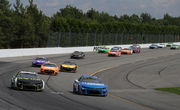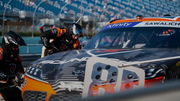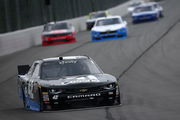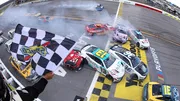
via Getty
DARLINGTON, SOUTH CAROLINA – SEPTEMBER 01: Denny Hamlin, driver of the #11 Sport Clips Haircuts Toyota, looks on after the NASCAR Cup Series Cook Out Southern 500 at Darlington Raceway on September 01, 2024 in Darlington, South Carolina. (Photo by Meg Oliphant/Getty Images)

via Getty
DARLINGTON, SOUTH CAROLINA – SEPTEMBER 01: Denny Hamlin, driver of the #11 Sport Clips Haircuts Toyota, looks on after the NASCAR Cup Series Cook Out Southern 500 at Darlington Raceway on September 01, 2024 in Darlington, South Carolina. (Photo by Meg Oliphant/Getty Images)
In NASCAR, success isn’t just measured in checkered flags—it’s measured in sponsorship dollars. No matter how many races a driver wins, without financial backing, their future is never certain. Just ask Denny Hamlin.
Meanwhile, Helio Castroneves—an IndyCar legend making his NASCAR debut—has landed a massive sponsorship deal with Wendy’s. And to make matters even more ironic? He didn’t even have to fight for his spot in the Daytona 500. Thanks to the Open Exemption Provisional (OEP) rule, Castroneves is guaranteed a seat, while veterans like Hamlin grind harder than ever for financial backing.
ADVERTISEMENT
Article continues below this ad
Fate’s twisted game of contrast between Denny Hamlin and Helio Castroneves
In a twist of fate, however, Castroneves has secured a huge sponsorship from Wendy’s, a $3 billion fast-food giant, which will give him strong backing as he transitions from open-wheel to stock cars. Wendy’s Co. (WEN) which is currently trading at $14.49 per share, reflects its robust position in the market. The company’s financial health doubled with its brand recognition making it a formidable partner in the motorsports arena.
While Castroneves takes this big leap, meanwhile, in the other garage, Hamlin, one of NASCAR’s biggest stars, has found himself in perilous waters—without a primary sponsor for the first time in his Cup career. With two decades as his lead sponsor, FedEx finally dropped the bomb after the 2024 season, leaving Hamlin on the lookout for new backers. “It just doesn’t sit right,” Hamlin has said of the OEP rule. “It’s a guy like Helio, with all due respect, who hasn’t paid his dues in NASCAR, and yet he gets a free pass into the biggest race of the year?”
For Castroneves, the OEP rule has proven to be quite lucrative as it assures his participation into the most coveted NASCAR events. Unlike other participants of the Daytona 500 who have to vie for a chance in the race, the rule ‘awards’ places to the highly regarded drivers from other series. This – combined with the presence of Hamlin in the forefront complaining about the rule – has proven the concept to be highly controversial.

USA Today via Reuters
Jan 30, 2022; Daytona, FL, USA; IMSA Series driver Helio Castroneves celebrates by spraying champaign in victory lane after his driving team won the Rolex 24 at Daytona International Speedway. Mandatory Credit: Jasen Vinlove-USA TODAY Sports
Although Coca-Cola and Sport Clips support Hamlin, his financial problems are alarming. In fact, FedEx was his anchor sponsor ever since his rookie season. He’s been vocal about the decline of marketing opportunities in NASCAR, claiming that the sponsorship market is increasingly more difficult for established drivers to navigate. “In our sport, sponsorship dollars aren’t flowing like they used to,” Hamlin said. “Teams are having to work harder than ever to get money and it’s not as simple as being a good driver.”
This season, Hamlin will have King’s Hawaiian as a sponsor for a few events, but it’s a far cry from the full-season, single-brand sponsorship he had with FedEx for nearly 20 years. The contrast between Castroneves and Hamlin is a symptom of a larger shift in the competitive and financial landscape of NASCAR. Castroneves, as a crossover star new to the sport, receives the buzz and marketability of being a crossover star. Hamlin, however, must fight for dollars like never before despite his mind-boggling success.
The purpose of the OEP regulation which involves awarding stars to the leading motorsport competitors in other areas is to popularize NASCAR. It is purely a question of fairness, does that count as NASCAR experience, or is recognition the only thing that matters? Meanwhile, Castroneves is set to rock the motorsport world right before the Daytona 500. With Wendy’s emblazoned on his back and his seatbelt fastened, he has nothing to lose. And Hamlin is realizing this for himself, or at least in his case, on the race tracks. But also on the boards in the boardrooms, where the business of advertising is won and lost.
Taking bets on this much: in the cutthroat culture of NASCAR speed, no one is owed anything—least of all the sport’s biggest names.
Trending
ADVERTISEMENT
Article continues below this ad
Uncertainty looms over the #11 JGR team
For over two decades, Denny Hamlin was the face of FedEx in NASCAR, a partnership so strong that his No. 11 car became synonymous with the shipping giant. But as the 2025 season looms, Hamlin finds himself in unfamiliar waters—without a primary sponsor for the first time in his career.
“It is tough out there,” Hamlin admitted. “Sponsorship is hard to come by, and certainly, while it is such an important time in our sport, sponsorship dollars are not flowing like they used to.” Hamlin’s words ring true not just for himself but for the sport as a whole. NASCAR is in the middle of a sponsorship drought, one that’s forcing teams to make tough choices and leaving talented drivers like Christian Rose without a ride.
Losing FedEx was a gut punch, but it wasn’t the only blow. Mavis Tires also pulled its support, leaving Hamlin and Joe Gibbs Racing (JGR) scrambling to secure new backers. While he still has partial sponsorships from Sport Clips, Yahoo!, and King’s Hawaiian, none of them agreed to a the full-season commitment that FedEx once provided.
ADVERTISEMENT
Article continues below this ad
If this sounds familiar, you’ve probably experienced it before. Kyle Busch, another JGR superstar, experienced the same thing when M&Ms ended its sponsorship in 2022. JGR could not find a replacement and didn’t have a choice but to transfer Busch to Richard Childress Racing.
As sponsorship dollars continue to dry up, one thing is clear—NASCAR’s financial landscape is changing. And if drivers like Hamlin and teams like JGR can’t adapt, they risk being left behind.
ADVERTISEMENT
ADVERTISEMENT
ADVERTISEMENT
ADVERTISEMENT






